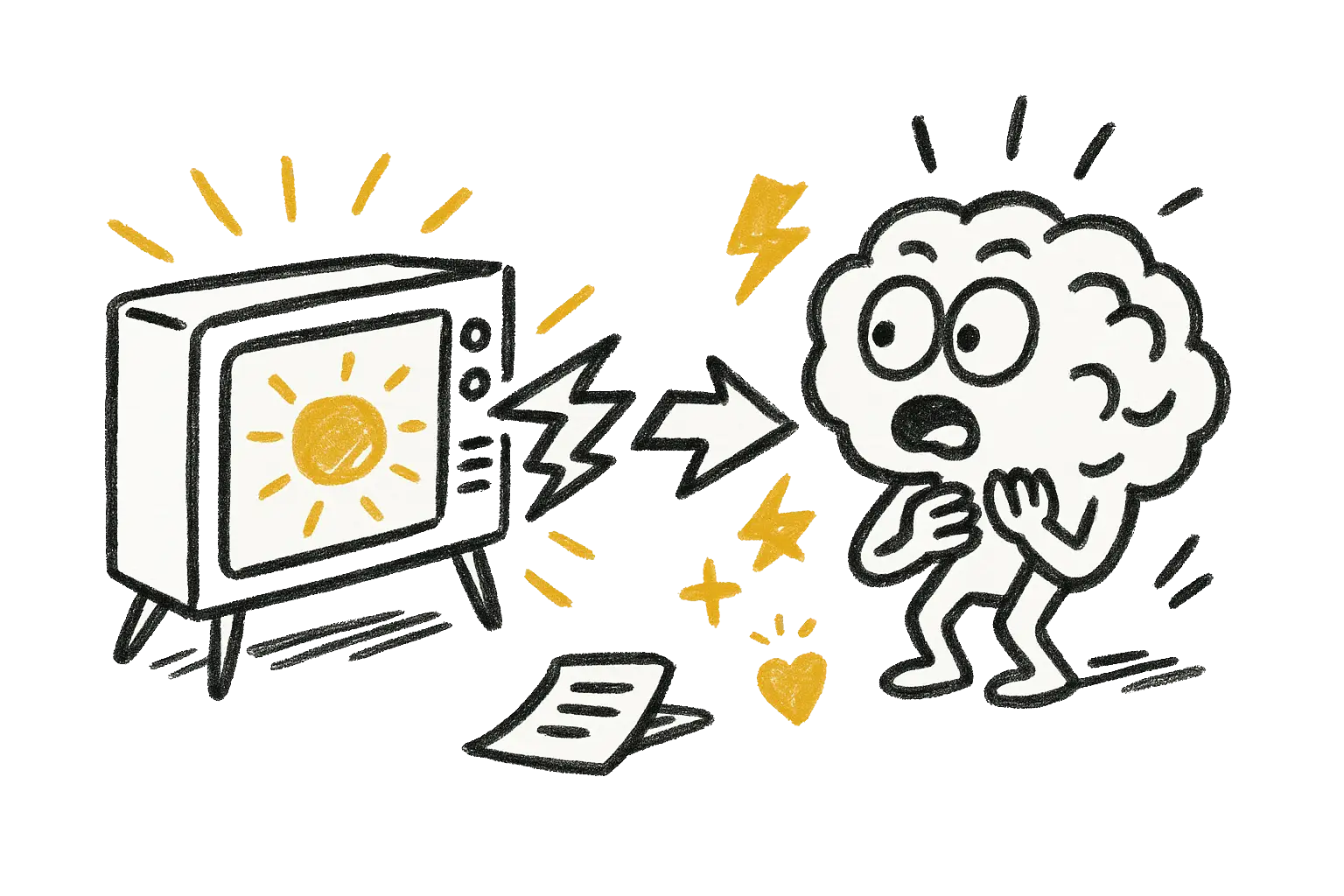The Myth of the “Slower Brain”: What TV Really Does for ADHD

When Bad Science Sounds Believable
A friend recently told me something her doctor said that made my eyebrows shoot up.
According to him, television keeps ADHD minds focused because “the frame rate and pixel refresh match a slower brain.”
Slower brain? Matching pixels? This sounded like the kind of pseudo-neuroscience that spreads faster than a TikTok trend. Still, I understood why she believed it. When you have ADHD or love someone who does, you start noticing the strange paradox: people who “can’t focus” in school or at work can spend hours locked into a screen. It does look like TV or games somehow fix attention.
But the truth is far more interesting—and a little more complicated.
ADHD, Dopamine, and the Need for Stimulation
ADHD isn’t about having a “slower” brain. It’s about having a brain that’s wired to crave stimulation.
Research shows that people with ADHD have lower baseline activity in the dopamine D2/D3 receptor systems, especially in brain areas that control motivation and sustained attention—the prefrontal cortex and striatum (Volkow et al., 2009). Dopamine is the neurotransmitter that tells us something is rewarding or worth paying attention to. When those pathways are underactive, the world can feel like it’s running in slow motion—until something exciting comes along.
So when TV, video games, or short-form videos enter the scene, the ADHD brain lights up. These media are engineered for constant novelty: bright visuals, fast cuts, punchlines every few seconds, dramatic music, and emotional payoffs. Each new stimulus delivers a mini dopamine “hit.” It’s not that the content slows down to match the mind—it’s that it speeds up enough to feed the brain’s hunger for novelty and reward.
Why Passive Media Feels So Good
Television demands almost nothing from the brain’s executive functions—the systems that plan, organize, and resist distraction. Those are the very functions that tend to run on low fuel in ADHD.
When someone with ADHD watches TV, the attention doesn’t have to be directed or sustained by effort. It’s captured—pulled along by constant external cues. The pacing of TV shows and YouTube videos is designed to prevent boredom. The storylines rise, peak, and resolve predictably, and all the viewer has to do is react.
That’s why people with ADHD can watch for hours even when they can’t finish a homework sheet or stay in a lecture. It’s not that the TV “fixes” their attention—it bypasses the system that struggles by handing the work off to external stimulation.
The Reward Loop: How Media Hooks the ADHD Brain
Television, video games, and social media all operate on different reward schedules, but they share one thing in common: they know exactly how to keep dopamine flowing.
| Feature | Television | Video Games | YouTube/TikTok |
|---|---|---|---|
| Type | Passive | Interactive | Hyper-stimulating, rapid |
| Attention Mode | Reactive | Active | Reflexive/compulsive |
| Reward Timing | Predictable | Variable | Random, constant |
| Executive Control | Low | Moderate | Minimal |
| Dopamine Activation | Mild | High | Very high (brief spikes) |
| Skill Transfer | Minimal | Some (short-term gains) | None |
| ADHD Impact | Temporary calm | Temporary focus/hyperfocus | Increased impulsivity/shorter focus |
TV offers predictable “feel-good” beats—like laughter, cliffhangers, and music cues that arrive just when your attention might flag. Games add variable rewards, which are even more powerful: you never quite know when the next bonus will come, and the anticipation itself triggers dopamine release.
Then there’s TikTok and YouTube Shorts—the ultimate attention trap. Every swipe is a new and unpredictable stimulus. The brain treats each one like pulling a slot machine lever: maybe the next clip will be hilarious, shocking, or emotionally charged. That uncertainty drives compulsive scrolling, particularly in ADHD brains wired to seek out fast, frequent rewards.
Hyperfocus Isn’t the Same as Focus
One of the great misconceptions about ADHD is that people with it “can focus just fine when they want to.” But what looks like focus—say, watching five episodes in a row—is actually hyperfocus: a state of total absorption in something stimulating.
Hyperfocus isn’t voluntary. It’s not discipline—it’s the brain locking onto a high-dopamine activity and refusing to let go. When the stimulation stops, attention collapses. That’s why ADHD focus is situational, not consistent: it depends on how rewarding the task feels in the moment.
The Double-Edged Sword of High-Stimulation Media
All this stimulation can feel good, even calming. For someone whose brain is constantly underpowered for reward, that flood of dopamine is soothing—like white noise for the nervous system. Some video games even show short-term benefits for visual attention and working memory (Bavelier et al., 2011).
But there’s a cost. Studies show that fast-paced media exposure can impair executive function and reduce tolerance for delay, especially in kids (Lillard & Peterson, 2011; Christakis, 2018). When the brain gets used to quick novelty, slow tasks—reading, homework, even conversations—feel unbearable. Over time, that widens the gap between what the ADHD brain craves and what life requires.
What the Science Actually Says
The claim that TV “matches” a slower brain is not only wrong—it reverses the truth. TV captivates ADHD minds because it over-delivers stimulation, not because it synchronizes with sluggish neural timing.
ADHD brains are under-stimulated, not “slow.” High-stimulation media temporarily bridge that gap, but they don’t train the systems that sustain attention when novelty fades. In fact, the more the brain relies on external stimulation, the less able it becomes to generate focus internally.
Finding Balance: Using Media Without Losing Focus
Understanding this dynamic doesn’t mean TV or games are the enemy. It just means we need to use them with awareness. The research points to a few practical principles:
- Encourage slow, real-world play. Art, outdoor exploration, building things—these activate multiple senses and naturally strengthen focus.
- Choose interactive media wisely. Educational games can build certain skills without triggering the rapid reward loops that foster compulsive use.
- Limit hyper-stimulating formats. Short-form videos like TikTok or YouTube Shorts are especially potent for ADHD brains; they’re best treated like dessert, not dinner.
- Create “stimulation variety.” Mix high-reward and low-reward activities to help the brain tolerate slower, more effortful focus over time.
The goal isn’t abstinence—it’s balance. A healthy media diet lets ADHD brains get the novelty they need without conditioning them to expect it every few seconds.
Reflection
After that conversation with my friend, I couldn’t stop thinking about how easily myths like this spread. A well-meaning doctor repeats an idea that sounds “techy,” and suddenly it becomes a story people trust about their own minds. But the science paints a much more nuanced picture—one that doesn’t shame or oversimplify.
It’s not that ADHD brains are slow. They’re hungry—wired for reward, novelty, and stimulation in a world that often doesn’t move fast enough for them. Screens feed that hunger, but they also train it. And the real challenge, for both kids and adults, is learning when to chase stimulation and when to build it from within.
References
- Volkow, N.D., et al. (2009). JAMA — Lower dopamine D2/D3 receptor availability in adults with ADHD.
- Sonuga-Barke, E.J.S. & Castellanos, F.X. (2007). Trends in Cognitive Sciences — Default-mode interference theory of ADHD.
- Christakis, D.A. (2018). Pediatrics — Fast-paced media and attentional conditioning in children.
- Lillard, A.S., & Peterson, J. (2011). Pediatrics — Immediate effects of TV on executive function in preschoolers.
- Weinstein, A. (2010). Behavioral and Brain Functions — Dopamine activation during video gaming.
- Kühn, S., & Gallinat, J. (2014). Molecular Psychiatry — Structural brain changes in habitual gamers.
- Bavelier, D., et al. (2011). Neuron — Video game effects on visual attention and impulse control.
- Turel, O., et al. (2018). Psychiatry Research: Neuroimaging — Social media use and gray matter reduction.
- Montag, C., et al. (2021). Frontiers in Psychology — Short-form video, addictive traits, and ADHD correlations.


Member discussion